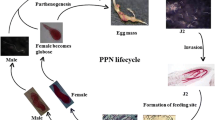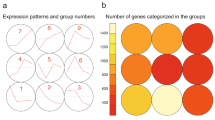Abstract
Plant parasitic nematodes are ubiquitous and cosmopolitan pathogens of vascular plants and exploit all parts of the roots and shoots, causing substantial crop damage. Nematodes deploy a broad spectrum of feeding strategies, ranging from simple grazing to the establishment of complex cellular structures (including galls) in host tissues. Various models of feeding site formation have been proposed, and a role for phytohormones has long been speculated, although whether they perform a primary or secondary function is unclear. On the basis of recent molecular evidence, we present several scenarios involving phytohormones in the induction of giant cells by root-knot nematode. The origin of parasitism by nematodes, including the acquisition of genes to synthesize or modulate phytohormones also is discussed, and models for horizontal gene transfer are presented.
Similar content being viewed by others
Author information
Authors and Affiliations
Rights and permissions
About this article
Cite this article
Bird, D., Koltai, H. Plant Parasitic Nematodes: Habitats, Hormones, and Horizontally-Acquired Genes. J Plant Growth Regul 19, 183–194 (2000). https://doi.org/10.1007/s003440000022
Issue Date:
DOI: https://doi.org/10.1007/s003440000022




